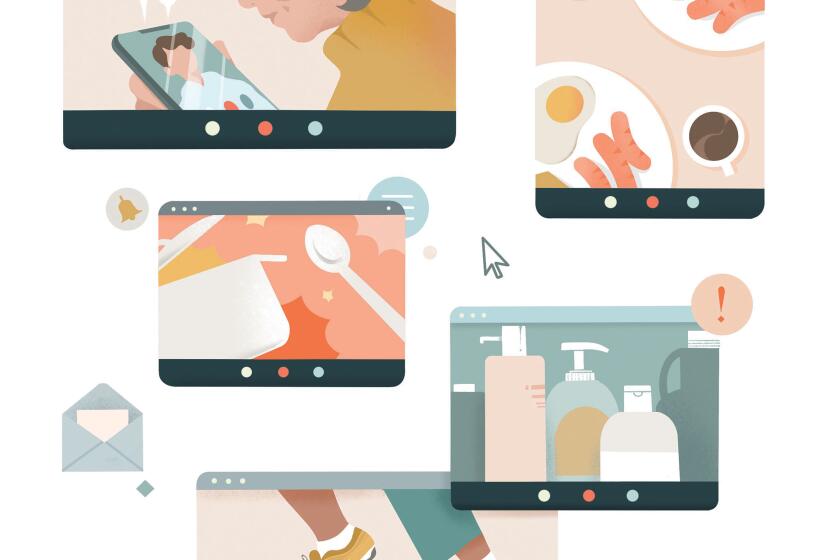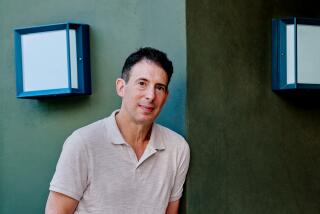Forget Zoom. In letters, we can find a better way to connect
- Share via
I timed out on Zoom almost as soon as we all started being “safer at home.” Extended video chats make me feel more, not less, distanced from the people who matter to me.
Maybe it’s the narrow bandwidth of home WiFi, the lag, the stumbling over folks’ words, the “I’m sorry!” “No-no-no, you first,” or the way a face sometimes freezes mid-thought, stretched into a detail that would be at home on a Dali canvas.
Also, I stare into screens too much — laptop, smartphone, e-reader. By day’s end, I crave IRL interaction, something I can touch, something that brings the people I love into the room in the ways I most recognize them.
On an “essential” bill-paying run to the post office, I masked up and held my breath planning on a quick “contactless” dash to the mail slots. Instead, I lingered, marveling at the line of customers waiting for help and embracing stacks of multicolored envelopes and packages.
It hit me: Letters! Care packages! This was how to bridge the distance and be an ally.
In our “Dispatches From the Pandemic” series, we bring you personal stories from people whose lives have been altered by COVID-19.
In my early 20s, I was a dedicated postal correspondent. When my friends departed L.A. for college and long-distance telephone calls were too expensive to consider, we fell back on letters. I built a stash of inexpensive colored envelopes and matching tablets. Later, I made my own stationery — busy collages and, eventually, ’zine-like Xeroxed pages personalized for each recipient.
I spent hours hunting for the right collection of images to add another layer to every story. I thrilled at the payoff: postmarks from New York, Prague, London, Chicago, San Francisco. Exotic stamps. Visitors almost daily.
We weren’t tied to an appointed hour. There were no transmission hiccups. Just line after line of unique ballpoint or penciled script calling my friends into the room before me whole, their voices distinctive, perhaps less-self-conscious than ever because they were confiding something unexpected until they put it on the page.
“I’m writing this sitting on a ledge of my dorm room’s window; it’s too loud to think inside. I hope the campus police don’t spot me. And I end up in the campus paper I edit.”
New plan determined, I rescued a box of fancy writing paper I’d splurged on a few years ago but hardly ever used. “Faster to email,” was always my default. This beautiful paper was for a rainy day. That day was now.
I scratched out a draft but the tone felt off. “Hey, how u?” wasn’t going to cut it. I had to start somewhere and build to something. In this slowed-down moment of a speeded-up era, how to be meaningful yet casual? What was worth a stamp? What part of me and my life in this strange interlude should I conjure?
Stepping away, I took a stroll past my bookshelves, the volumes of correspondence between friends and lovers and never-met-in-person pen pals. Ralph Ellison’s letters. Allen Ginsberg’s dashed-off notes to Lawrence Ferlinghetti, F. Scott Fitzgerald’s late-night worries and regrets. The best of these missives aren’t concerned with headlines of the day or even life markers, like weddings or births. Instead, they hold to the incidentals gliding past, intimacies that locate writer and reader in the moment: The money is running low, the editing is tough, someone broke the front window at City Lights bookstore.
My friend Lenny, long gone, once admonished me for beginning a letter with a description of the weather. Point taken. But all these years later, I’m not unhappy about having led with the marine layer because now I have his ire-laced, amusing response in hand and, as well, his suggestions for what might have been more meaningful. His letters are small jewels. They bring him back, full-force and in fine form.
I think I know what he was pressing for — not the wan backdrop or the high drama but the specifics of a day. The surprise of a small vegetable garden miraculously taking root in the impossible soil outside the back door. The birds building nests in the eaves. Christmas decorations that have suddenly reappeared on front lawns in late spring.
In April, the U.S. Postal Service announced that the coronavirus shutdown was killing it; it was on track to lose $2 billion a month. A little later, the headlines shifted: Some post offices were processing packages at a rate higher than during the holidays. And here in Los Angeles, 500 new employees were needed to help with the unexpected demand. I’m not the only one who’s been struck by the need for something other than a virtual connection.
I’ve unearthed those colored tablets, my fountain pens, even my old manual Smith Corona. Elements that can put me in the room, if you will. Two to three small notes a day are floating out of my hands into the U.S. mail. Cards and letters are arriving from across the country and from friends cooped up just across town.
They contain the small asides, the seemingly throwaway moments we wouldn’t bother to share on Zoom or FaceTime but that will last to tell another story to my future self: This is how we found camaraderie and comfort when the world turned upside down.
Lynell George’s latest book is “After/Image: Los Angeles Outside the Frame.”
More to Read
A cure for the common opinion
Get thought-provoking perspectives with our weekly newsletter.
You may occasionally receive promotional content from the Los Angeles Times.










